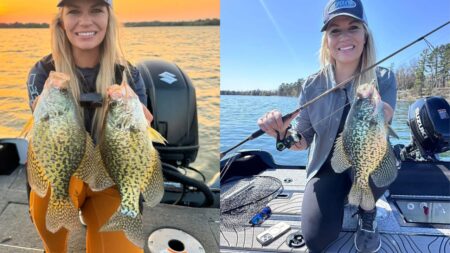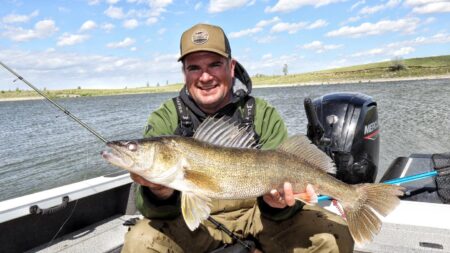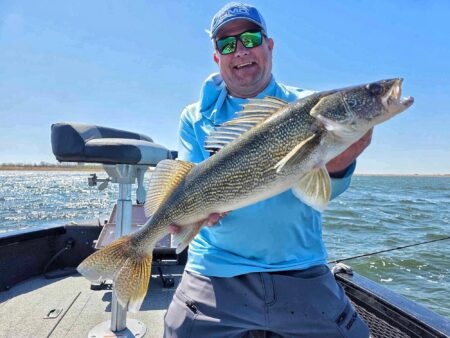Choosing the best ice fishing lures for jumbo perch starts by understanding the environment they live in. From upstate New York to Idaho, perch are remarkably adaptable and can occupy several different niches in an ecosystem. From one body of water to the next, you will see perch take on several different personalities. Perch can be extremely aggressive or very passive. Perch can be found roaming extremely shallow water or roaming deep basins. On some fisheries, perch will suspend. The primary forage for perch can range from water fleas and freshwater shrimp to crayfish and shiners. Tactics for catching perch will run the gamut. On Saginaw Bay, you might be high lifting a single hook bead spoon in six feet of water. On Gogebic, perch fishing might mean using dead sticks and wigglers. On the Madison Chain, you might be fishing for deep suspended fish with dropper chains and a few miles away on Kengonsa, fishing small spoons in shallow weeds.
In the Dakotas on many of the shallow prairie dish bowl lakes, perch might be found running basin transitions, and small tungsten jigs tipped with waxworms or spikes are the program where you almost have to dead stick the rod when a fish comes in. Go to Winnibigoshish or Leech Lake and the program might be much more aggressive with 1/8th ounce spoons and a full minnow.
What to Look For When Choosing Perch Lures

When breaking down perch water and choosing the best lures, there are a couple of things I look at that I believe are extremely important. The first factor is forage. I am don’t get hung up on “matching the hatch” per se as some of the best colors can be fire tiger or gold when nothing the fish are eating seems to be fire tiger or gold. When looking at forage, look at the build of the fish. Take a twelve-inch perch from different fisheries. You will notice two distinct builds of fish. Some fish have big shoulders and extremely small heads and mouths… these fish are typically in environments where they are eating bugs and invertebrates. Small heads mean small mouths and these fish are used to eating smaller profiles that are not very good at getting away. The second build of fish you find on some fisheries can also have the same impressive girth but have big heads and mouths. Perch that have big mouths typically live on water where they are running down shiners, crayfish or other fish to eat. These fish attack lures more and are often much more aggressive by necessity. A thirteen-inch perch from Devils Lake for example has a mouth like a soda bottle. A thirteen-inch perch from Green Bay has a mouth like a small bass. As a rule of thumb, small mouths mean smaller lures and more subtle presentations for fish that are not as aggressive. Big mouths mean larger lures and more aggressive presentations to trigger more aggressive fish. Again, rules of thumb and generalities, starting points for choosing lures. There are always exceptions of course.

Rule number two when determining the best lures is how the fish are schooling. When perch are running along the bottom and spread out where they are swimming next to each other, they usually are not as aggressive as when they swim through the water where fish are swimming stacked up on top of each other. Perch swimming through an area in a column for example where you have multiple fish stacked one above the other the fish are usually much more aggressive. The aggressive fish are often moving fast. For fish that are not as aggressive and schooling where they swim side by side, the number one play in the playbook is simply changing the shape of the school. Attempt to lift up fish. If you can get one fish to lift and then another, your odds of getting a bite improve dramatically when you can get multiple fish to lift up and stack one on top of the other. Fish that lift and stack can be caught with more aggressive presentations, fish that won’t lift or stack usually need more finesse. Fish that are at the top of the school are usually more aggressive and fish that are willing to run off the bottom are usually more aggressive.
Below is a spectrum of some of our favorite perch lures ranging from aggressive to subtle with suggestions on situations where to use them along with an overall fishing strategy starting with most aggressive to tougher, pull your hair out, bites.
Aggressive Perch Lures
Single Hook Spoon
On the best bites, perch will hit just about anything and the game is simply drilling enough holes to find them. On a really hot bite, simple single hook spoons shine for a few reasons. A large single hook is much easier to pop out and get back down to the fish. The length of the spoon enables the unhooking. Classics include the old Russian spoons and bead spoons. New spoons include the Clam Blade Jig. For optimum efficiency, tip the spoon with a perch eye where legal. Soft plastics like the Maki Mino XL are also an excellent tipping option and durable for multiple fish. On a really good bite, especially in shallow water… pinch the barb down and slightly bend out the hook so fish become unhooked faster.
Flutter Spoons

Flutter spoons are typically thin metal spoons that put off a lot of flash as they flutter horizontally though the water. This added flash and slow flutter on the drop really call aggressive fish in. Flutter spoons shine whenever fish are suspending in the water column or in shallow water less than twenty feet. Flutter spoons also often work better if there is no or little current. Flutter spoons can be tipped with a perch eye when legal or a minnow head, waxworms or spikes. When fish are really aggressive, you can catch fish without tipping the spoon. High lifts and falls can work well for bringing fish in and the flash can pull aggressive fish in from long distances.
A great flutter spoon for perch is the CPT Leech Flutter Spoons. Go with the larger sizes when looking for fish or when fish are aggressive. Scale down to the smaller sizes when fish need some finesse.
Horizontal Glide, Swim and Rattle Baits

We are combining several aggressive horizontal hard baits into one lure category because they all fish similarly. Classic glide baits include the Jigging Rap which is a very versatile lure that can drop through the water fast to get back down to fish and this lure also fishes well if there is any current. A cult favorite amongst some ice anglers is the Salmo Chubby Darter. The Chubby Darter has a much slower and more seductive wobble that really shines in less than twenty feet of water. A new glide bait that has been really hot the last few years includes the CPT Tikka Mino which features some sick high visibility colors and a durable metal fin. Rattle baits like the Rapala Rippin Rap can also wear perch out. At times, you need to tip the bottom treble hook with bait. With this lure category, a high lift or a hard pounding jigging cadence can attract fish while less aggressive fish may require a bounce or shake on the rod tip to generate strikes when fish are on top of you.

Progression to Less Aggressive Perch Lures
Lead/Metal Spoons With a Split Ring/Treble Hook

One of the most popular lure categories for perch that is very versatile. Larger sizes can be used for aggressive fish with the larger profile having the capability of pulling fish from much further distances. The smaller sizes can be scaled down and fished with much more finesse. Anglers often tip the treble hook with bait. These spoons can be constructed from Zink, lead, or some other metal and some of these lure options have rattles. There are some days when rattles are important for additional sound as fish are attracted to the noise. There are other days where the fish don’t like the additional noise or the noise is not a factor. Great non-rattle options include the Clam CPT Blade Spoon or Pinhead Minnow. Other honorable mentions include the Northland Fishing Tackle Forage Minnow, Acme Kastmaster and Bay De Nock Swedish Pimple. For rattling spoons, check out the CPT Rattling Blade Spoon or the Northland Tackle Buckshot Rattle Spoon.
Less Aggressive Perch Lures
Spoons with Dropper Chains

Winter perch anglers have long customized spoons with droppers or chains. A dropper chain is a simple chain with a hook that hangs below the spoon and attached after removing the treble hook off the split ring. You can also tie a dropper below the spoon with a six-inch piece of monofilament line or fluorocarbon line and attach a small jig or single hook. Droppers or chains are popular because the weight of the spoon gets the presentation down through the water fast and also can be seen from further away. When fish require a little bit more finesse where the perch are attracted to the spoon but hesitate to strike, the smaller hook hanging below the spoon on the chain or dropper seals the deal. Some spoons are sold with chain droppers like the CPT Speed Spoon. You can also buy chains ready to attach to spoons from VMC and Hali. You can basically take any spoon and attach a dropper or chain. As a rule of thumb, we like the chain droppers the best as they have a more delicate dance and flash that seems to triggerfish and are often very durable.
Horizontal Jigs

As we scale down to more finesse, smaller profile horizontal jigs enter the scene. With the horizontal jig game, tungsten is quickly replacing lead on many fronts because tungsten is heavier than lead and has many advantages on many bites because tungsten drops through the water faster and feels much more sensitive. The heaviness of tungsten allows anglers to scale down to even smaller profiles on tougher bites without losing the sensitivity. The deeper the water and the smaller the profile, the more tungsten can become an advantage. Great horizontal jigs include the Clam Drop XL which has a larger wide gap hook which is usually important for perch fishing for not only hooking fish but also more quickly unhooking fish and getting back down to the school. One of our personal favorite jigs when using waxworms or spikes for bait is the Clam Drop Kick Jig as the longer shank of the hook allows anglers to pack a lot of bait on the hook so you can catch multiple fish without having to rebait as quickly. These jigs can be tipped with live bait like wax worms, spike or a minnow head along with a perch eye when legal. Other tipping options include a full minnow or soft plastic.
For soft plastic options, there are options that imitate minnows or young of the year fish along with imitations or profiles that mimic invertebrates or insects like mayfly larvae, freshwater shrimp, wigglers or dragon fly larvae and blood worms. For larger minnow imitating profiles, the Maki Mino XL is deadly. For imitating bugs, look at the Maki Jamei, Maki Bloodi along with the Impulse Mayfly.
Listed Perch Lures:
- Makki Mino XL
- Maki Jamei
- Clam Blade Jig
- Flutter Spoon
- Salmo Chubby Darter
- Clam Blade Spoon
- Forage Minnow
- Kastmaster
- Buckshot
- Clam Speed Spoon
- VMC Dropper Chain
- Clam Drop Jig XL
- Sweedish Pimple Ice Jig
- Tikka Mino
- Drop Kick Jig
- Rattlin Blade Spoon
- Pinhead Minnow
- Jigging Rap




